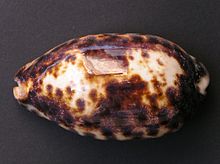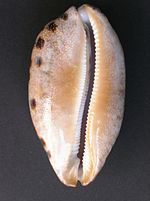- Chelycypraea testudinaria
-
Chelycypraea testudinaria 
Dorsal view of a shell of Chelycypraea testudinaria Scientific classification Kingdom: Animalia Phylum: Mollusca Class: Gastropoda (unranked): clade Caenogastropoda
clade Hypsogastropoda
clade LittorinimorphaSuperfamily: Cypraeoidea Family: Cypraeidae Subfamily: Luriinae Genus: Chelycypraea Species: C. testudinaria Binomial name Chelycypraea testudinaria
(Linnaeus, 1758)Synonyms[1] - Callistocypraea testudinaria (Linnaeus)
- Callistocypraea testudinaria ingens Schilder
- Cypraea testudinaria Linnaeus, 1758 (basionym)
- Cypraea testudinaria ingens (Schilder & Schilder)
- Cypraea testudinosa Perry, G., 1811
Chelycypraea testudinaria, common name : tortoise cowry, is a species of sea snail, a cowry, a marine gastropod mollusk in the family Cypraeidae, the cowries.[1]
There is one subspecies : Chelycypraea testudinaria ingens Schilder, F.A. & M. Schilder, 1939 [2]
Contents
Description
The shells of these quite uncommon cowries reach on average 90–110 millimetres (3.5–4.3 in) of length, with a minimum size of 75 millimetres (3.0 in) and a maximum size of 142 millimetres (5.6 in). They are variable in pattern and colour. The shape is oval or sub-cylindrical, the dorsum surface is smooth and shiny, the basic color is whitish or yellowish and it is covered by very irregular dark brown patches and spots. The margins are white or pale brown, with some large dark dots. The base may be whitish, pale brown or pink, the aperture is long and narrow and the teeth are white, short and fine. In the living cowries the mantle is bluish-greyish and almost trasparent, while sensorial papillae are lighter and rather long. Mantle and foot are well developed. The lateral flaps of the mantle may hide completely the dorsum surface.
A shell of Chelycypraea testudinaria, dorsal view, anterior end towards the right A shell of Chelycypraea testudinaria, lateral view, anterior end towards the right
A shell of Chelycypraea testudinaria, lateral view, anterior end towards the right
Distribution
This species is distributed in the Indian Ocean and in the Pacific Ocean along Aldabra, Chagos, the Comores, Kenya, Madagascar, the Mascarene Basin, Mauritius, Mozambique, Réunion, the Seychelles, Zanzibar and Tanzania, Malaysia, Samar Island, Sulu Sea, Vietnam and Philippines (excluded Hawaii).
Habitat
These cowries live on coral reef, in crevices and beneath large rocks in shallow subtidal waters at 5–15 metres (16–49 ft) of depth.
References
- ^ a b Chelycypraea testudinaria (Linnaeus). Accessed through: World Register of Marine Species at http://www.marinespecies.org/aphia.php?p=taxdetails&id=530893.
- ^ Gastropods.com : Chelycypraea testudinaria ingens; accessed : 23 october 2010
- Drivas, J. & M. Jay (1988). Coquillages de La Réunion et de l'île Maurice
- Verdcourt, B. (1954). The cowries of the East African Coast (Kenya, Tanganyika, Zanzibar and Pemba). Journal of the East Africa Natural History Society 22(4) 96: 129-144, 17 pls
External links
Categories:- Cypraeidae
- Animals described in 1758
Wikimedia Foundation. 2010.



